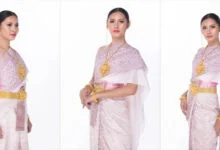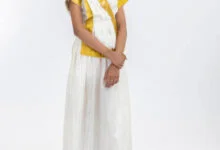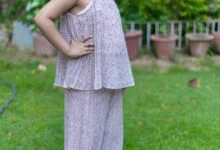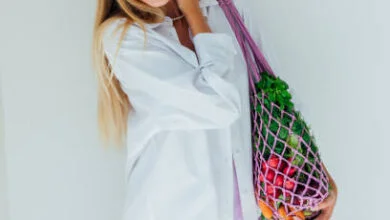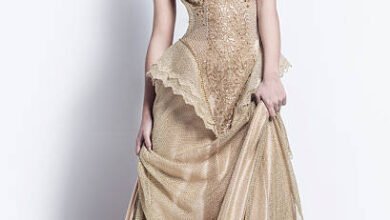The Timeless Elegance of Dhoti Salwar Suit Design

The Timeless Elegance of Dhoti Salwar Suit Design
There is a dhoti salwar suit in the bright tapestry of Indian ethnic wear which creatively interlaces modernity and tradition. This costume has an unconventional approach to salwar kameez styles and it is popular among fashion conscious people and ethnic attire enthusiasts. From where it came from to the modern fashion shows that have taken over, this design of dhoti salwar suit shows how Indian traditional outfits remain beautiful and flexible.
Historical Origins of the Dhoti Salwar
For so long, the dhoti has been a must have for men’s wardrobe but its innovation into women wear especially dhoti salwar is revolutionary in Indian fashion. The transformation is a hybrid of cultural legacy and current trends thus making dhoti salwar an interesting subject for fashion historians.
Cultural Significance of the Dhoti Salwar
With regard to Indian traditional clothing, the dhoti salwar occupies a unique position that provides both style and comfort. It is not just about appearance but also its importance of cultural transformation in which traditional styles blend with modernity and fit into the changing society.
Essential Elements of the Dhoti Salwar Suit
A typical dhoti salwar suit includes three key parts:
Dhoti Salwar Bottom: It is known for its distinct draping style that resembles a men’s traditional dhoti.
Suit Top or Kurti: Most times they are created to match the flow and volume of the dhoti salwar, while being focused on ease and style.
Dupatta: The dupatta can be an optional add-on that adds charm to the outfit, which serves as a multi-purpose accessory enhancing overall look.
Fabric Choices for Dhoti Salwar Suits
The fabric selection is important as it determines how a dhoti salwar suit will drape and feel. Some of the most popular ones include cotton, silk, georgette and chiffon; each has its own degree of comfort, fluidity and appropriateness for different occasions.
Traditional Versus Modern Dhoti Salwar Designs
Intricate embroidery, vibrant colors and motifs inspired by nature and regional art forms are often associated with traditional dhoti salwar designs. On the other hand, modern interpretations are more towards minimalism with low key colors, slick lines and modern prints.
Features of Traditional Dhoti Salwar Suits
This is manifested by the use of costly materials, intricate workmanship as well as traditional features like zari, gota patti and mirror works. They are frequently preferred because they present a royal aspect and remind one of their ancestry.
Influence of Regional Styles on Dhoti Salwar Designs
The diversity of India’s cultural landscape is reflected in the regional variations of dhoti salwar suits. From the opulent styles of Punjab to the understated elegance of South India, regional influences imbue dhoti salwar designs with distinctive charm.
Contemporary Adaptations of the Dhoti Salwar
In today’s fashion world, designers have rethought the traditional dhoti salwar for the modern woman by adding features such as asymmetrical hems, fusion prints and unusual pairings. These latest designs are aimed at global market and demonstrate that dhoti salwar suits can be used in several ways.
Popular Colors for Dhoti Salwar Suits
Traditional dhoti salwar suits are known for their bright hues and bold patterns, which make them look very rich; however, modern palettes have added soft colors, unicolors as well as dull shades that resonate with current fashion trends.
Embellishments Used in Dhoti Salwar Designs
Often, the artistic nature of dhoti salwar suits is brought out by means of ornamentations like embroidery, sequins, lace and beadwork. The suit’s elegance is raised by adding these decorative elements that bring about texture and visual interest.
OR
Dhoti salwar suits are often described as embellished with things like embroidery, sequins, lace and beadwork to highlight their artistry. These decorations bring in a sense of texture and visual attraction that makes them appear more elegant.
Draping Techniques for the Dhoti Salwar
A peculiar way of draping characterizes the dhoti salwar with its multifarious drapes. By mastering the technique of draping, it is possible to alter the image and charm of this type of clothing, thereby making it suitable for different figures.
Different Variations of Dhoti Salwar Bottoms
Design innovations have brought about different looks of the dhoti salwar bottom such as those with layers, frills and pegged inwards. These variations give women a wide range of choices to reflect their fashion sense.
Neckline and Sleeve Options for Dhoti Salwar Tops
The flexibility of the dhoti salwar suit also goes to the top or kurta, along with a number of neckline and sleeve designs. There is no limit to the kind of round necks, boat necks and bell sleeves available among others.
Fusion Styles Incorporating Dhoti Salwar Elements
The traditional essence of dhoti salwar has been blended into western wear, which is part of fusion fashion. The innovative outfits have been able to reach out to a wider audience by way of this cross-cultural exchange.
Dhoti Salwar Suits for Formal Occasions
Instead of the conventional formal wear, one can opt for dhoti salwar suits made from luxurious materials and decorated with fine embroidery to give an elegant look. They show sophistication and pride in our culture.
Casual Dhoti Salwar Designs for Everyday Wear
The loose and comfortable nature of a dhoti salwar makes it perfect for everyday and social wear. Lightweight materials and plain patterns ensure function without sacrificing style.
Bridal Dhoti Salwar Ensembles
Bridal dhoti salwar suits is becoming a popular choice among modern brides for pre-wedding functions or as alternative wedding dress. The clothes mix both heritage and independence, so that the prospective brides can get a different look on this important day of their lives.
Dhoti Salwar Suits for Festivals and Celebrations
Modern brides are increasingly choosing bridal dhoti salwar suits as an alternative to traditional wedding gowns for their pre-wedding functions or even for the main wedding. The blend of tradition and personal style in these outfits allows each bride to look different on her special day.
Styling Tips for Wearing Dhoti Salwar Suits
Modern brides are increasingly choosing bridal dhoti salwar suits for pre-wedding functions or as an alternative wedding dress. They are not ordinary clothes because they combine traditionalism with uniqueness and present the bride in a different look on this particular day.
Accessories that Complement Dhoti Salwar Outfits
Adding the appropriate accessories can transform a dhoti salwar suit from ordinary to outstanding. It is important to properly accessorize for this outfit with statement jewelry, classy clutches and fashionable shoes.
Dhoti Salwar Designs for Different Body Types
This characteristic of dhoti salwar suit makes it a good choice for all types of bodies. By selecting the right material, size that matches and style, one can highlight their strong points and at the same time be at ease with themselves.
DIY Dhoti Salwar Suit Customization Ideas
For the creative people, customization of dhoti salwar suit is an avenue for personal style to be fused into traditional clothing. It can be differentiated by blending different fabrics, colors and embellishments together.
Sustainability in Dhoti Salwar Fashion
People who have creativity and a penchant for it can personalize their dhoti salwar suits in order to add on traditional customs. By trying different fabrics, colours and adornments, one can come up with an exclusive outfit.
Creative individuals may also choose to customize a dhoti salwar suit as a way of blending personal style into traditional attire. Trying out different fabrics, colors, and accessories will help create a unique ensemble.
Celebrity Influences on Dhoti Salwar Trends
Trends in ethnic wear, including dhoti salwar suits, are often set by celebrities and fashion icons. Their choices can inspire new designs and make traditional attire famous among a larger audience.
Cultural Appropriation Versus Appreciation in Dhoti Salwar Fashion
As salwar-kameez skirts become famous worldwide, it is important for us to know the difference between cultural appropriation and cultural appreciation. When a dress’ cultural worthiness is acknowledged and its elegance extolled, it makes the sharing of cultures possible.
Impact of Globalization on Dhoti Salwar Designs
Dhoti salwar suits are increasingly becoming popular worldwide, so it is important to understand the difference between cultural appropriation and cultural appreciation. This means that even while we celebrate their beauty, we should not forget the significance vested in the attires.
Dhoti Salwar Suit Design Trends for the Current Year
Cultural appreciation and cultural appropriation are two different things, so it is important that people realize where the distinction lies as dhoti salwar suits continue to gain worldwide recognition. In order to ensure cultural exchanges that are respectful, one must both respect the cultural significance of the said attire and at the same time celebrate its aesthetics.
Future Predictions for Dhoti Salwar Fashion
The future of dhoti salwar fashion looks promising, with designers continuously exploring new territories in design, sustainability, and cultural expression. The dhoti salwar suit’s adaptability and appeal suggest it will remain a cherished part of Indian ethnic wear for generations to come.
Conclusion: The Enduring Charm and Versatility of the Dhoti Salwar Suit Design
The dhoti salwar suit symbolizes India’s rich cultural heritage and its ongoing dialogue with the modern world. Its evolution from traditional attire to a contemporary fashion statement underscores the creativity and resilience of Indian design. Whether adorned for a formal occasion or embraced as everyday wear, the dhoti salwar suit continues to enchant with its elegance, comfort, and versatility, proving that traditional attire can thrive in the modern age.

